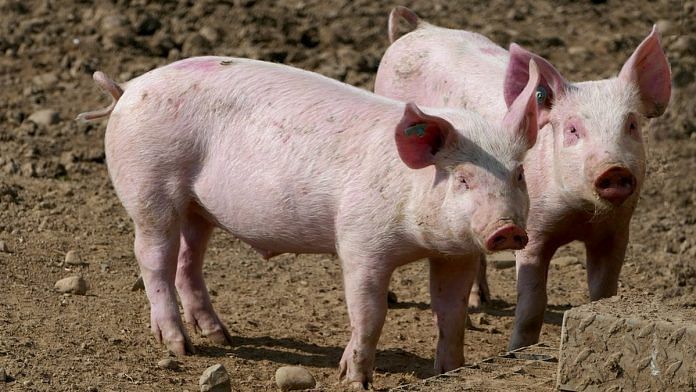Bengaluru: American scientists from Yale and Case Western Reserve University have managed to revive cellular activity in the brains of dead pigs.
In a study published in the journal Nature Wednesday, researchers said parts of the brain can actually be revived hours after an incident of oxygen depletion.
Oxygen flow and the brain
Studies have shown that the brains of mammals are highly sensitive to the flow of blood and oxygen. Within seconds of interrupted blood flow, mammals can lose consciousness. Also, electrical activity in the brain can reduce drastically as brain cells can quickly switch their charge from positive to negative.
In the absence of oxygen, or if oxygen levels fall, the mitochondria — known as the powerhouses of the cell — start to shut down quickly while an amino acid called glutamate accumulates in the nerves. This kind of cascading, multiple layers of dysfunction in the brain have always been thought to lead to permanent brain damage, or worse, brain death.
However, scientists have started to question this conclusion in the light of several new studies in which brain cells, which have been sampled from people who’ve been dead for several hours, have shown possibilities of revival. The same was found for mitochondria, which was revived ten hours after the death of a person.
In one case, a monkey’s brain was resuscitated after an hour of low oxygen level.
Even among humans, after episodes of severe hypothermia (when the body loses heat faster than it can produce heat, causing a dangerously low body temperature), complete revival with no permanent brain damage has been possible.
Also read: How Chinese scientists created monkeys with human brain genes
The experiment
To understand if recovery is possible after a prolonged period of death, the group of researchers worked on reviving the brains of 32 pigs that had been dead for four hours.
The brains used in the experiment belonged to four-to-six-month-old pigs, and were procured from US Department of Agriculture-regulated food processing facilities. They would otherwise have been discarded.
The brains underwent ‘perfusion’, a process in which an artificial circulatory system was used to pump blood into the brain through connections to the carotid arteries.
Traceable particles were placed inside the brains of the dead pigs that could track the blood flow. The blood was made to flow through this system for six hours.
Findings
The researchers quickly found that the blood flow was robust and brain tissues showed immediate revival. The vast majority of mitochondria that had started to dysfunction also jumped back to activity upon exposure to oxygen, while the cell membranes returned to their original charge.
“We observed attenuation of cell death and preservation of anatomical and neural cell integrity,” the study said.
Neuron activity in the hippocampal region of the brain was also successfully revived, as were the temperature, oxygen, and glucose levels in the brains. The sodium/potassium balance was also successfully restored an hour after the perfusion began.
“We also found that specific cellular functions were restored,” the authors wrote in the paper.
Implications
The study does not imply a complete awareness in the brain, or any form of awakening at all.
“This study provides us with evidence that although brain cells start to shut down minutes after blood supply is interrupted, under the right conditions, specific fundamental brain functions can be restored hours after the complete interruption of blood flow,” Ahmed A. Khalil, a stroke-imaging researcher, told ThePrint.
Khalil works with the Center for Stroke Research Berlin (CSB) and the Max Planck Institute for Human Cognitive and Brain Sciences. He was not connected with the study.
“This, of course, by no means suggests that the brain returns to ‘functioning’ in the colloquial sense of the word, where it becomes conscious or aware, is able to detect and respond to external stimuli, control bodily functions etc.,” he added.
“However, in cases of trauma such as accidents or during episodes like stroke where there’s a decrease in supply of oxygen to the brain, we can hold out hope longer than we did before and design treatments and therapies that can reverse the damage caused by lack of oxygen.”
There’s another interesting implication of this study, according to Khalil. “It suggests that researchers might be able to use samples collected hours post-mortem (within a specifically designed system like the one used in this study) to study brain functions that could previously only be studied in living animals,” he said.
Having said all that, scientists are still not close to reviving consciousness or awareness in a dead brain.
“The gap between basic cellular functions being somewhat intact and ‘awareness’ is vast,” said Khalil.
With this experiment, scientists now are venturing into unchartered territories, ethically. Conducting experiments on a dead animal has always been acceptable as it cannot feel pain. However, such experiments may lead us into newer discussions and updated definitions of death. Even though we haven’t reached that point yet, if the brain is even partially functioning, is the animal still alive? While we can’t classify this case as a live animal at all, new ethical guidelines would still be needed in such grey areas of study.
As ethicists wrote in the commentary accompanying the paper, “There’s a big difference between mostly dead and all dead. Mostly dead is slightly alive.”
Also read: What is the best sense? Scientists are still battling it out



